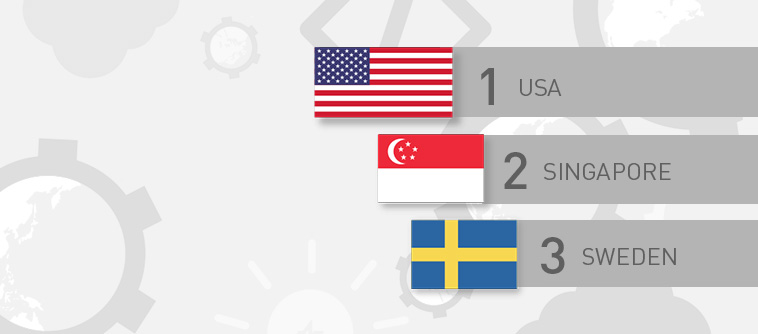
IMD World Digital Competitiveness Ranking 2019
Now in its third year, the IMD World Digital Competitiveness Ranking measures the capacity and readiness of 63 economies to adopt and explore digital technologies as a key driver for economic transformation in business, government and wider society.
» Download the IMD World Digital Competitiveness Ranking 2019
Technology not only affects how businesses perform but also how economies function and prepare for the future. Governments around the world are investing heavily in their digital economy to enhance value creation and prosperity.
The Top 5 share a common thread in terms of their focus on knowledge generation, but they each approach digital competitiveness differently. The United States and Sweden follow a balanced approach between knowledge generation, the creation of a supportive environment for technology development and a readiness to adopt innovation. Singapore, Denmark and Switzerland give priority to one or two factors.
“In the midst of uncertainty and a fluid global situation, it seems that business and societies that are agile correlate strongly with the IMD World Digital Competitiveness ranking. Knowledge also remains of paramount importance for the digital performance of different economies,” stated Professor Arturo Bris, Director of the IMD World Competitiveness Center.

Research Information & Knowledge Hub for additional information on IMD publications
- IMD World Digital Competitiveness Ranking 2019
- IMD World Digital Competitiveness Ranking 2020
- IMD World Digital Competitiveness Ranking 2019
- IMD World Digital Competitiveness Ranking 2020
Research Information & Knowledge Hub for additional information on IMD publications
1 October 2020, 4th edition
Research Information & Knowledge Hub for additional information on IMD publications
The case describes two transformation journeys for ABN AMRO bank. The first transformation is cultural and the second is digital. It explores the interplay between these two journeys from the perspective of the head of the Personal Banking. The ca...
The B case picks up at the end of Case A. It’s now autumn 2022. Klaas Ariaans and Eric Jones, leaders within ABN AMRO’s Personal and Business Banking Division had been reflecting on the success of self-organization in their divisions. This new wor...
A great way for executives to hone their communication skills is by having a coach listen in on their conversations and provide feedback. But given the increasing capability of AI-based tools to have meaningful conversations with people, research...
The China Resources Beer (CR Beer) case study is a compelling narrative of the world’s largest beer producer by volume under the leadership of CEO Hou Xiaohai. In 2016 CR Beer embarked on a pivotal transformation journey. This case study offers cr...
Five friends created DIDA in 1983 and turned it into a global provider of IT infrastructure and services. Riding the wave of rapid growth of communication networks and increasingly global business relationships of corporations, DIDA established it...
Research Information & Knowledge Hub for additional information on IMD publications
The B case picks up at the end of Case A. It’s now autumn 2022. Klaas Ariaans and Eric Jones, leaders within ABN AMRO’s Personal and Business Banking Division had been reflecting on the success of self-organization in their divisions. This new wor...
Research Information & Knowledge Hub for additional information on IMD publications
The case describes two transformation journeys for ABN AMRO bank. The first transformation is cultural and the second is digital. It explores the interplay between these two journeys from the perspective of the head of the Personal Banking. The ca...
Research Information & Knowledge Hub for additional information on IMD publications
Research Information & Knowledge Hub for additional information on IMD publications
in I by IMD 24 January 2025
Research Information & Knowledge Hub for additional information on IMD publications
Research Information & Knowledge Hub for additional information on IMD publications
Research Information & Knowledge Hub for additional information on IMD publications
NTT Corporation, Japan’s information and communication technologies (ICT) leader since 1953, was the first to commercialize internet usage on mobile phones in the 1990s, which resulted in NTT achieving much success in Japan. However, by the end of...
Building on NTT (A), the case starts with NTT’s CEO having narrowed down strategic growth options with the board to prepare NTT for the future. Past international investments in AT&T Wireless and KPN to tap into foreign markets had resulted in bil...
Research Information & Knowledge Hub for additional information on IMD publications
in I by IMD Brain Circuits 15 January 2025
Research Information & Knowledge Hub for additional information on IMD publications
in I by IMD 14 January 2025
Research Information & Knowledge Hub for additional information on IMD publications






